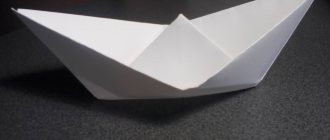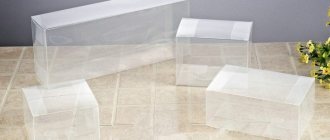How to make a boat with your own hands: 4 models from scrap materials
Are you ready to open navigation? April is approaching - and with it deep streams and real seas of the streets. “It’s a shame...” the adults will complain. "Funny!" - the kids will laugh in response and, putting on colorful rubber boots, will immediately rush to launch the boats.
Making children's boats with your own hands is a simple matter, and for parents it is also a wonderful reason to spend time with their child. First, try taking our ready-made ideas as a basis, and only then your imagination will tell you new unique ships from scrap materials!
Can you make boats?
Do you know how to make a paper ship for your son, grandson, or any child? If the answer is no, then you are welcome to read this useful article. Here you will find a description of different methods of making paper and other ships. Moreover, some options involve co-creation between an adult and a child. Let's remember simple models of paper boats that come from our distant childhood.
Making a boat with your own hands: what you need
The photo shows the materials for making all 4 presented boats.
- dry branches of various lengths and thicknesses
- toothpicks, wooden skewers, or thin plastic tubes (such as lollipop sticks)
- sandpaper
- thread or rubber bands
- cardboard
- lightweight floating material (foam plastic, foam scraps or any other foam insulation)
- colored paper (or white - because you can draw or print any sails and flags on it)
- Colored electrical tape is also perfect for flags.
- scissors
- stationery knife
- reliable waterproof adhesive suitable for working with a wide variety of materials
- materials for decoration - acrylic paints (cannot be washed off with water and are suitable for woodworking), colored pencils, felt-tip pens, wax crayons, glitter gel, etc.
DIY wooden boat
Both models are based on a raft knitted from branches. The arrangement of the “logs” can be absolutely anything: choose which design you like best, or invent your own, improved one.
To begin with, the branches need to be processed: cut off the bark and all irregularities with a utility blade (only under adult supervision!), and if necessary, sand the surface with sandpaper.
Now you should thoroughly think through the future design...
...and then firmly tie the logs together using thread or an elastic band.
DIY cardboard boat
Of course, making the deck entirely out of cardboard is simply not practical. It’s better to reinforce it from below with some lightweight water-repellent material (you probably have something similar left at home after renovating or purchasing household appliances). Polystyrene foam or, as in our case, foam insulation, similar in texture to polyurethane foam, is perfect for these purposes.
Using a stationery knife (which children work with only under adult supervision!) we cut out the floating part of the future ship. We sand off the uneven surfaces.
We trace the contours of this part on cardboard and cut it out.
In the center of the cardboard piece we make a slot into which we insert a pre-cut captain's bridge and a toothpick mast.
We put a flag on the mast (in the photo it is made of green electrical tape), and glue the floating part from below.
DIY foam boat
The base is the same foam insulation as the previous vessel. The sails are made of ordinary paper, and the masts are made of the same sticks that remain from caramel.
Building these boats with your own hands for children is very simple and quick. I wish you a fair wind and a joyful spring!
How to make boats bright, noticeable and unique?
Use various paints, pencils, markers, stencils and other decorative means.
DIY ship model
You can create a model of an antique ship yourself without purchasing a ready-made structure for assembly. To achieve a high-quality result, you will have to show a lot of patience and perseverance.
To make a historical ship with your own hands, prepare:
In this model of the ship, not plywood was used as a base, but balsa wood. The choice was due to the ease of working with the material. Unlike plywood, where you need a saw for cutting, with balsa wood everything was done with a simple sharp knife. You can also take thin strips for work from any material, they just have to bend well. Wood glue should not be replaced with hot glue, much less super glue.
Step 1
.
On paper you need to draw the main details of the future ship. You can print them if you find suitable layouts on the Internet. Please note that your ideas may undergo slight changes as you work. This is not critical if you just want to build a ship in an old style, and not repeat an exact copy of a specific ship. Read also: How to make a sketchbook with your own hands
Step 2
. For convenience, work with the ship was divided into several parts. The ship itself was also assembled. Most of the time was spent making the central part of the ship. Then the front, rear and deck parts with the mast were made.
Step 3
. First of all, using the existing sketches, make the skeleton of the ship. Be sure to make sure that all its edges are symmetrical. If there is a slight deviation somewhere, correct these flaws. Check that when attaching the ribs, they are exactly at an angle of 90 degrees.
Step 4
. Once the skeleton is ready, start decorating its sides. To do this, glue a long strip along the center line of the side part. Continue to focus on it when you glue the rest. It is better to glue the slats in stages to make your work easier. Apply enough glue, but make sure that it does not flow down the slats. Additionally secure the slats using clamps, leaving them in this form until the glue has completely dried. After the glue has dried, remove the clamps and continue gluing the slats in the next area.
Step 5
. Fill all areas where gaps form between the slats with epoxy resin. When ready, coat all parts of the ship with wood varnish.
Step 6
. After the main work, move on to finishing. You can hide all possible aesthetic flaws at this stage. To do this, carefully glue slats over areas with obvious defects to hide them. You can make a horizontal line from rattan, emphasizing the smooth shape of the ship. The base of the ship is ready.
Step 7
. Masts need to be made from wooden rods and small flat pieces of wood. There will be two masts in the ship. Adjust the rods in advance to the calculated dimensions. To attach the masts, cut two pieces of wood measuring 4 x 2 cm. Drill holes in them for the mast rods. Make a reinforcing lattice from small rods and assemble the entire structure.
Step 8
. Make a template for the ship's deck from paper and, based on it, build a deck part from wooden strips. After letting it dry thoroughly, drill holes for attaching the masts. Insert and glue the masts. Use plywood to make the side rails of the ship.
Step 9
. Glue the wooden strips at the front and back of the ship in the same way. They need to be glued to the side and in the deck part, and rods and handrails should be made from pieces of plywood. All parts are fastened with wood glue. Don't forget to raise the back of the ship with steps.
Step 10
. The final part of the entire building process is to assemble all the parts of the ship together. By gluing everything together with wood glue, you get the finished base of a historical vessel.
It can also be supplemented with small parts and sails. The entire assembly takes a total of 4 - 5 days and most of the time is spent allowing the glue to dry.
What to make a fishing boat from? Complete list of components for DIY assembly.
On our website you can independently select components for the boat, which you will assemble with your own hands. All components are checked before shipping. When purchasing from Amazin.su, you do not have to waste time returning and replacing defective goods.
Motor and speed controller for hand-built bait boat:
The motor is the heart of the carp boat, with the help of which it is able to go to the far corners of the reservoir. In this case, the motor requires a speed controller that allows you to accurately vary the electrical power supplied to the electric motor.
Brushed 540 motor. Due to its availability, it is the most popular solution for hand-built bait ships. Works in conjunction with a 320A speed controller. Motors have different numbers of winding turns, from 10T to 55T - roughly speaking, the higher the number of turns, the more revolutions the electric motor makes.
Brushless RC motor 5010 750kv Best in price/performance/reliability ratio. The motor will accelerate the boat assembled on the basis of the hull of the Amazin Angler bait boat to 17 km/h! Has proven itself well with Flycolor speed controllers.
Servo drive for bunkers and boat rudder:
The most reliable solution will be the time-tested SERVO DS3218 . They create a force of 20 kg, which is more than enough to reset the hopper and even more so to turn the steering wheel. These are the ones that are used on the ship for delivering hand-made Amazin Angler bait.
If you want to save money, then take a look at the budget option TD8120MG . It also creates 20 kg of force, but is inferior in the quality of the gears and drives from which it is assembled to its older brother DS3218.
Economy option - MG996R . It applies 10 kilograms of force and is equipped with just plastic gears. We recommend using it only if your boat is repairable and replacing a failed servo drive is not difficult.
Super economy –
MG90S .
A force of 1.2 kg will only be enough to turn the steering wheel, and only if it is well lubricated. Let us remind you that cheap Chinese steering wheels quickly fail due to the fact that a minimum of lubricant may remain inside them. To operate these rudders correctly, you need to lubricate them after each fishing trip. If you are assembling a boat for more than one season, it is better to overpay 500 rubles and buy a handmade steering wheel, inside of which about 25 grams of lubricant is pressed. This steering wheel will last at least 10 years. We guarantee. More information about the steering wheel can be found here.
Equipment (control panel) of a fishing boat.
The control equipment includes a remote control, which will be in your hands, and a receiver, which will be in the ship. There are plenty to choose from, but manufacturers of hand-built ships have settled on the following options:
FlySky i6 equipment. It is used with a 6-channel iA6b receiver or with a 10-channel iA10b receiver. The number of channels depends on the number of servos, lighting equipment and additional iBus sensors. Typically, for a ship with two bunkers and one lighting line, 6 channels are enough.
Flysky FS-i4 equipment. A four-channel receiver will provide support for the required minimum set of components. Let's count together: 1st channel for the steering wheel, 2nd channel for the speed controller (and, accordingly, the motor), 3rd channel for connecting the servo of the first bunker, and 4th channel for the second bunker (if the boat has a single bunker, then to turn on/off the backlight).
Rudder for bait boat:
Chinese steering wheel. The design of the steering wheel is simple, the material is the cheapest - that’s why the price.
Hand assembled steering wheel. The steering shaft and blade are made of brass, which means the steering wheel will never rust. About 25 grams of lubricant is pressed into the steering deadwood, which will never be washed out with water thanks to the pressed bushings. We recommend using a servo with a force of at least 10 kg with this steering wheel.
Deadwood and coupling for a self-assembled boat.
DIY cardboard ship
Ship modeling is interesting and exciting. Marine themes are always popular. Stories about bloodthirsty pirates, brave explorers and warriors of past centuries are always fascinating. How to make a boat out of cardboard, what is required, how difficult is it? This article will help you find the answers. Detailed master class on creating products, tips and tricks.1
Making a boat from wine corks
A sailboat made from wine corks can be a good alternative to the above designs. To make such a boat, it is enough to have:
- Three plugs;
- Nylon thread;
- Toothpick;
- Colored paper.
Using a gypsy needle, you need to make holes through the plugs so that the latter can be connected to each other with a nylon thread. A toothpick with a sail made of colored paper is stuck into the middle cork and the boat is ready.
Features of working with cardboard
Cardboard is a dense and reliable material from which, if desired, you can make various crafts. Working with it will not cause any difficulties if you apply these tips:
- if the cardboard is thick, take sharper scissors or cut it with a stationery knife,
- when you are going to bend the finished parts of the product along the drawn dotted lines, trace their outline with the blunt side of your scissors or with a non-writing pen - the cardboard will bend easily and much smoother,
- A glue gun is effective, but not always suitable - if the material is thin, it is easier to replace the strong glue with PVA or regular office glue,
- make sure that the room where you will work is not too humid, otherwise the finished products will then delaminate or the parts will not stick together properly,
- ventilate your room regularly, adjust the lights,
- if the model is complex, watch videos instead of text master classes,
- work in stages when the mood is good.
Read also: How to make an incubator with your own hands
Beginners usually start simple, gradually making the task more difficult for themselves. Anyone can make a ship out of cardboard, even a child. If you follow all the instructions.
Making a boat from foam plastic
Lightweight ball-shaped material can serve as the basis for the frame. Foam plastic is cut well, which gives the young designer the opportunity to experiment with shapes.
And don’t ask yourself how to make a spaceship? It is enough to find a large piece of foam plastic to cut out the desired design from it, guided by the impressions of watching “Star Wars” or “Starship Troopers”.
The finished spaceship can be launched. And if it exactly repeats the design of the muse, then it belongs on the shelf next to ships in a bottle. By the way, foam plastic can be painted, which is good for young artists.
Matchbox boat
Who said you need special cardboard? Any available material will do. For example, several empty matchboxes have accumulated at home. Great, then this master class will do.
- Take 2 boxes, connect them at the ends and carefully glue them. Glue the third one on top of them.
- Cut a long strip of paper. Make sure its width matches the size of the box. Now cover the boxes with it.
- Cut a thin (1-1.5 cm) strip of cardboard, then fold it in half. Glue tightly to the boxes, forming the nose of the future ship.
- Draw outlines on the remaining piece of cardboard, outlining the bottom of the vessel.
- Mast. Cut ¼ of the sheet and roll it diagonally tighter. Make a small round hole at the top of the future ship. Treat it well with glue, then insert the end of the mast there.
- Cut out sails and a small flag from paper (colored sheet). Using a regular hole punch, make a pair of round holes in the finished sails. Thread them one by one through the mast, and glue a flag on top.
To make a ship made from ordinary cardboard brighter with your own hands, you can paint the finished craft.
Interesting options for homemade boats
Simple boat
Children as young as 3-4 years old can make a simple boat. A square sheet of paper is folded diagonally, then again. Approximately in the middle of the bottom line of the resulting triangle, mark a reference point. A small triangle is folded upward from this point, carefully smoothing out the folds. Mark the approximate line of the side, bend and turn out the sides on both sides. If the boat is made from plain paper, you can color it with pencils or felt-tip pens.
Classic boat
The classic look is familiar to many from childhood. The rectangular sheet must be folded in half and the middle marked on the fold. Fold the sides towards the middle. The rectangular part from below is bent upward, the workpiece is turned over, and the action is repeated.
The corners formed on the sides are inserted into the base of the workpiece on both sides - first the upper ones, then the lower ones. If you need a paper headdress, then you can stop at this stage. But if you do make a boat, then you need to straighten the workpiece in the shape of a square, connecting the opposite corners, and turn the lower corner of the top layer up, then turn it over and repeat. Straighten the workpiece again and fold it into a square. Gently pull the top corners to the sides.
Simple sailboat
A sailboat can be made from a square sheet that is folded in half horizontally and vertically. The top and bottom of the workpiece are bent towards the middle. Next, the side parts are bent towards it. The upper corner on the right side must be straightened, smoothing its lower diagonal fold. Straighten the remaining corners in the same way. Next you need to pull the halves of the workpiece - the right one towards you, the left one away from you. Turn the protruding lower corner to the right. Use a drop of glue to connect the sides in the bow.
Colored sailboat
The colored sailboat is made from blue and white single-sided paper. The square sheet is folded in half horizontally and vertically. The workpiece is turned over on the other side and folded diagonally. On the white side, two opposite corners are bent towards the center.
To form the sails, you need to bend the workpiece so that you get a white triangle on top, located vertically. Repeat on the other side. To reduce one of the sails, you need to bend it down and then up again, leaving a small fold that is tucked inside. The lower part of the sailboat is bent to the reverse side, and from the front side the craft looks like a blue boat with white sails.
Twin-pipe steamer
This steamer is made up of a square. Bend the sheet diagonally to mark the center point. All four corners bend towards the center. The workpiece is turned over and the action is repeated. The craft is turned over again, and the corners are again bent towards the center. There are pockets in the corners of the workpiece, two of which, in opposite corners, must be opened. The unopened corners are stretched, and the result is a toy that will not only look good on a flat surface, but also behave quite steadily on the water.
Boat
The boat has a more complex design; school-age children can handle it. A square sheet of paper is folded diagonally, marking the center of the workpiece. The top and bottom lines are folded towards the center to form a rectangle.
All four corners of the workpiece are bent towards the middle. Next, the two upper and two lower corners are folded towards the middle (do not forget to properly iron the folds with your fingers or a ruler). The upper and lower corners of the resulting diamond are brought to the center of the workpiece, the model is turned inside out and takes its place in the paper flotilla.
There are still many options for making boats using the origami technique. Motor ships, catamarans, motor boats, cutters, junks - for children who are interested in mastering origami, you can select increasingly complex patterns with step-by-step instructions. The main thing is that the process of creating a new toy brings pleasure to the child.
Milk carton ship
Run out of milk at home and still have a box left? Great! You can make a real ship.
- Manufacturers use special cardboard for milk; in addition, it is waterproof, you can even organize “swims”. A long 1L box is used here.
- First, you need to carefully cover it all with opaque tape (so that the ship does not advertise a dairy company).
- Measure and mark on the box all the places that need to be cut. Draw lines with a felt-tip pen and, following them, cut through the box with scissors, forming the base of the boat.
- Some parts (as seen in the pictures) are cut out separately.
- Attach two sticks symmetrically at the bottom rear to the stern of the future vessel. Connect the ends with a regular elastic band (pharmacy grade will do).
- Attach the rectangle - the motor screw. The ship is ready, all that remains is to paint it or add other details - figures of people, make a steering wheel.
Pirate ship
A real pirate ship is recognizable by the color of its sails, flag and other visual features. You can supplement the finished product with Lego figures - pirates. It is worth involving a child in the work - the process is fascinating and at the same time educational.
- cardboard box,
- glue gun,
- ruler,
- pencil,
- breadboard knife,
- a piece of polystyrene foam,
- twine,
- branches (collect small ones),
- fabric (for pirate sails),
- templates
- You can draw diagrams for the ship with your own hands from cardboard, but if your drawing skills are poor, it is better to choose ready-made templates. Select the ones that suit you, print them out and carefully transfer them onto cardboard.
- Step by step cut out one side of the future vessel, then the second. It is better to choose (or draw) simple templates, without complex squiggles.
- The ship needs 2 side, bottom and 1 back parts. Use a ruler to measure each one, making sure they fit.
- Using a glue gun, carefully connect the 2 sides to the back.
- Once dry, glue the bottom. It turned out to be a large cardboard boat.
- Find a long, straight branch in advance and cut off the excess. Attach the mast to a small square of foam, and glue it tightly to the bottom.
- Cut out a small “L” shaped, even piece from the cardboard, forming the stern. When finished, glue it to the back.
- You need 2 thin sticks or skewers - they need to be tightly attached side by side to the mast. These are the sail holders. To be sure, additionally wrap them with twine.
- Sail. Cut it (a regular medium-sized square) from fabric. Color it by drawing a dark pirate skull, make romantic scarlet sails or anything else you want.
- Make several small holes at the bottom along the edge of the fabric and at the top. Cut the twine into equal small strips and thread them through those holes. Tie the finished sails to two branches on the mast.
Read also: How to make squish with your own hands
Here's how to make a boat from an ordinary box and other scrap materials. By the way, the ship should be equipped with a yardarm (the pirates usually forced their captives to walk along it), a rudder, and a small anchor cut out.
floating ship
Why limit yourself to simple crafts when you can create a real ship that will float? Of course, you need to put in more effort, but the result will certainly please you.
- wide tape,
- a piece of foam plastic (does not sink),
- textile,
- cardboard,
- thin wire,
- cutter,
- wooden boards (small),
- threads,
- scissors.
- Frame. The step-by-step creation of a three-dimensional ship begins with its hull. Using a cutter, carefully cut out the hull, first forming the contours for the deck and bow. Then cut the two sides obliquely and make the bottom as flat as possible.
- You may need a stencil or photo of examples to create the poop. When tracing the lines, immediately leave 7 mm, draw again. Once finished, you can cut it out. You will get patterns for the skins of the future vessel.
- Decoration. Color the patterns. For example, you can take a photo of a pirate, military or ancient Viking ship. Separately, on the pattern of the future deck, mark all the places where you will install the masts. Carefully cover each cardboard model with tape. It will provide protection from possible getting wet.
- Now attach the finished patterns one by one to the foam base. To secure, use glue or tape.
- Masts. You make them from thin planks. Try to make the masts sharp at their base and narrowed at the top. Secure it with wire to the finished masts.
- Sail. Remember, if you are planning to make a sailboat out of cardboard, you will have to fit several masts and make larger sails. After all, sailboats moved thanks to the wind. After cutting out the sail, literally sew it to the finished mast. Use a needle to make several identical punctures, pass a thread through them, then tie the ends to the yards. According to the shape, it will be narrower in height. When finished, stick the masts with their sharp ends into the base of the ship.
- Steering wheel. It is needed so that the ship then sails straight. Cut a couple of identical pieces from ordinary cardboard, then symmetrically stick them in the stern area into the base itself, positioning them so that they reach the water.
- Test descent. Look, if the ship suddenly falls or rocks, attach additional weight below or inside - a nut or large bolt. It’s better to hang it by wrapping a wire 5-8 cm down from the bottom of the ship.
Cardboard steering wheel
What kind of ship will sail normally if there is no rudder? For a DIY ship's helm made from cardboard, you will need a ready-made template. However, if your drawing skills are sufficient, you can create a layout yourself.
- Draw two identical circles, then cut them out. Inside each you need to cut a second circle, but smaller, to make flat rims. Remember, the size of the headbands determines the size of the product.
- Cut out several small circles for the center of the steering wheel.
- Rays. Use a ruler to measure the length you need and adjust the skewers, removing excess with a knife.
- Carefully sharpen the ends of the beams. The junction should also be sharpened, so they will fit together better.
- Assembling the steering wheel. Having connected the rays and fastened them, cover the top with the second circle. Secure everything with glue. Repeat similar manipulations with the second, larger rim.
- To make the edge of the resulting steering wheel smoother, you can sand it with sandpaper.
- Wrap the ends of the rays alternately with thread, giving them the desired volume. That's it, all that remains is to paint the finished product and attach it to your ship. By the way, any model of vessel needs a steering wheel, be it a modern yacht, a steamship or a medieval sailing ship.
In order for the steering wheel to fit seamlessly, you need to make a boat out of cardboard, which was originally used to make the steering wheel.
Boats made from natural materials
Crafts made from natural materials can only be limited by the raw materials found and the imagination of the master. Leaves, branches, cones, boards or bark will work great. The main thing is to fasten everything correctly. It is best to use wood glue or, if the craft is large enough, self-tapping screws.
Crafts made from shell boats have the longest lifespan. By selecting several shells of the appropriate size (1 for the deck, 2 for the sails) and securely gluing them together, you can get a simple sailboat.
If desired and sufficient materials are available, the ship can be more complex. You can add shells of different shapes and sizes, corals or wave-rolled glass to it.
When creating crafts such as a boat, regardless of the chosen technique and manufacturing materials, it is important to take care of sufficient fastening of the finished product. Whether it is an applique or a three-dimensional composition, you need an adhesive that matches the surface.
At the same time, it is desirable that no traces remain when the adhesive composition dries. Ideally, you want a mixture that becomes clear when it sets. Otherwise, the product may be damaged.











